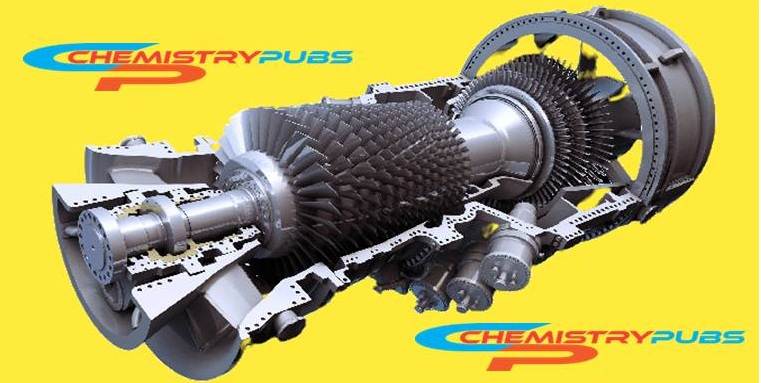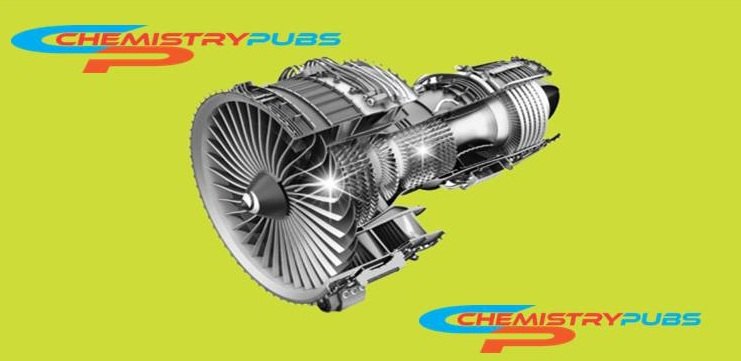A turbine is a rotating mechanical device that extracts the kinetic energy from a fluid like water, air, steam, or combustion gases &converts it into mechanical work. The construction of a steam turbine is very simple in which consisting of a rotor and a set of rotating blades. The rotating blades of this equipment are attached to a shaft and the shaft is placed in the middle of the rotor. An electric generator is connected to the rotor shaft of this equipment. This generator collects the mechanical energy from the shaft and converts it into electrical energy.
Parts
This equipment generally consists of some parts which descriptions are given below:
Steam chest and the casing: The body of this equipment connects to the higher-pressure steam supply line and the low-pressure steam exhaust line respectively. The casing of this equipment consists of the rotor and nozzles through which the steam is expanded and directed against the rotating buckets.
Rotor: It is the rotating part of this equipment which mainly consists of three-four or another number of blades. These blades are attached to the central part of the turbine. Blades are made of composite material which is to be light and strong. The blades are not flat and have a twist between their root and their tip. The blades of this equipment have the ability to rotate up to 90° about their axes.
Bearing cases: The bearing ceases to support the rotor as well as contain the journal bearings and the rotating oil seals. These prevent any type of outward oil leakage and the entrance of water, dust, and steam.
Casing sealing glands: This part helps to seal the casing and shaft which is made of spring-backed segmental carbon rings and supplemented by a spring-backed labyrinth section to produce higher exhaust steam.
Governor system: These systems have control systems that are integral to the steam turbine. The speed of this equipment can be controlled by varying the steam flow by positioning the governor valve. This system consists of spring-opposed rotating weights, a steam valve, and an interconnecting linkage.
Over-speed trip system: This system is very important for conducting the controlled system and closes the trip valve for stopping the flow of steam to this equipment in the event of over-speed conditions. This system generally consists of a spring-loaded pin or weight mounted in the turbine shaft on a collar and a quick-closing valve.
Labyrinth seal: This seal is essential to reduce leakage from the high-pressure side to the low-pressure side by allowing a small amount of leakage.
Carbon ring seals: These are formed by carbon ring segments held together by a retaining spring.
Nozzle ring and reversing blade assembly: The nozzle ring directs the steam flow from the steam chest to the Curtis stage first-row blades. The reversing blades reverse the flow of steam and direct the steam into the second row of blades of the Curtis stage.
Diaphragms: The diaphragms of the turbine are attached to allow for rotor deflection and to assure that the seals are concentric with the shaft.
Sentinel valve: This valve is a warning device which locates on the top of the exhaust end turbine casing, indicating excessive turbine exhaust end casing pressure. This valve releases a small amount of visible steam into the atmosphere, causing an audible sound.

Auxiliary steam valves: This valve is very essential to achieve more efficient operation with varying load or steam conditions. These are situated in the steam passageway between the steam chest and the nozzle ring.
Turning Gears: This gear helps to rotate the rotors slowly during warm-up, and cool-off. This part maintains the rotor at an approximately uniform temperature circumferentially, so as to maintain straightness and preserve the balance.
Generator: This electric motor converts the mechanical energy of the rotor, harnessed from wind to electrical energy. It has more rotational speed than a turbine rotor to generate electricity.
Working Principle of Turbine:
The blades of this equipment are heated by fluids. Then the blades of this equipment will start to move for generating energy from the moving fluid. The shaft of this equipment connects with a generator for converting mechanical energy into electrical energy.
Types
There exist mainly four types of this equipment which description is given below:
Water Turbine: This type of equipment is used in hydroelectric power plants to generate electricity. A large pipe arrangement known as a penstock is attached to this turbine. When water hits the blades with high velocity, it produces kinetic energy. Then the attached generator converts mechanical energy received from the turbine into electrical. This turbine is two types namely impulse type and reaction type.
Impulse Type: This type of equipment consists of several elliptical half-sized buckets which are arranged on the rotor instead of blades. The working policies of this equipment depend on Newton’s 2nd law. The rotor of this turbine starts revolving when the water hits the half-sized buckets at a very high speed. Then the kinetic energy of water is transferred into mechanical energy. Pelton Turbine is the best example of an impulse turbine.
Reaction Type: The working principle of this type of equipment follows Newton’s 3rd law. A toque is created by simply responding to the mass or force of a fluid. The wheel of this equipment rotates full & submerged in the tailrace after striking the water on the wheel with some pressure & supplies over the van. Kaplan turbine is the best example of an impulse type turbine which is used for high discharge with medium or less head.
Wind Turbine: This type of equipment changes the kinetic energy of the wind to electrical which are available in different sizes with either vertical or horizontal axes. This type of equipment is very sustainable, and affordable. It consists of three blades that can rotate after striking the air on the surface of these blades.
Horizontal-axis Wind Type: The blade size of this type of equipment is above 100 feet long so they generate more electricity.
Vertical-axis Wind Type: The blades of this equipment are connected directly to the top & the bottom of a rotor. This type of turbine is 50 feet wide and 100 feet tall.
Steam Turbine: This type of equipment is generally used in thermal and nuclear power plants for generating electricity. This equipment consists of a rotor & s stator which are arranged alternately to extract energy from it which is called compounding. Firstly, steam hits this equipment’s blades, which are arranged on a disc placed on a shaft. Then the dynamic force is produced on the blades through this high-velocity steam, where the blades & shaft start to rotate in a similar direction.
Advantages
There have various advantages of various types of type of this equipment which are given below:
The water tube type of this equipment is a clean & non-polluting source of energy. Water is the source of energy instead of fuel. The water turbines are very efficient, durable, with less operating cost, and eco-friendly, lubrication cost is low & operational speed is high.
Steam types of this equipment have higher reliability, low vibrations, need low mass flow rates, the power-to-weight ratio is high, high thermal efficiency, etc.
Disadvantages
There have many disadvantages of different types of this equipment which are given below:
The water tube type of this equipment uses a lot amount of water and creates a negative impact on our environment.
Steam type of this equipment requires a longer time to start and has higher installation cost, is less responsive, etc.
Wind type of this equipment creates noise pollution and produces a harmful effect on our environment.
Applications
Hydropower plants are used water turbines to generate electricity.
Head hydroelectric-based power plants are used impulse turbines to generate electricity.
Wind power mills are used reaction-type to generate electricity.
Steam turbines are very used in different types of industries like chemical industries, waste plants, oil, gas & sugar mills.
References
Glassman, A. J. (Ed.). (1973). Turbine design and application (Vol. 290). Scientific and Technical Information Office, National Aeronautics and Space Administration.

